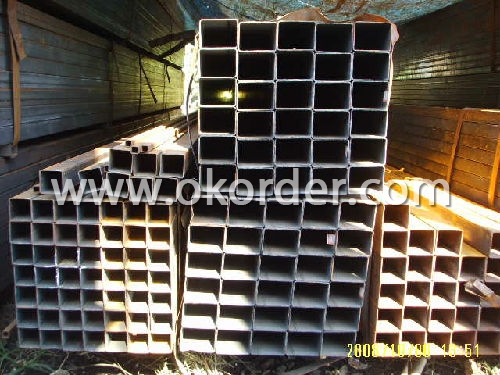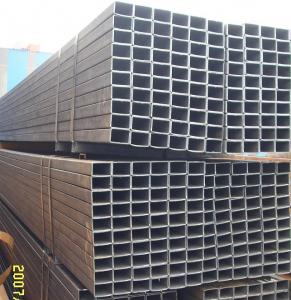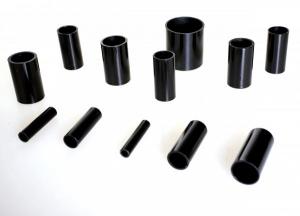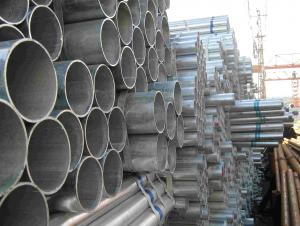Hollow Section Steel Tubes(Hot Rolled/Cold Rolled)
- Loading Port:
- China Main Port
- Payment Terms:
- TT or L/C
- Min Order Qty:
- 50MT m.t.
- Supply Capability:
- based on order m.t./month
OKorder Service Pledge
OKorder Financial Service
You Might Also Like
Hollow Section Steel Tubes(Hot Rolled/Cold Rolled)
Application of Hollow Section Steel Tubes(Hot Rolled/Cold Rolled)
It is widely used in building, machine, chemical equipment, automobile industrial, container, it is also applied to agriculture and mine machine.
ASTM A500, GB6728
Steel grade of Hollow Section Steel Tubes(Hot Rolled/Cold Rolled)
ASTM A500: A, B, C
GB6728:Q195,Q215,Q235,Q345
Size of Hollow Section Steel Tubes(Hot Rolled/Cold Rolled)
*Remark: Besides below sizes, we also can arrange production based on requirement of customers
Sizee(mm) | Thickness(mm) |
20×10 | 0.6-1.0 |
25×12 | 0.6-1.0 |
38×19 | 0.6-1.5 |
50×25 | 0.6-1.5 |
50×30 | 1.6-3.0 |
60×40 | 1.5-3.5 |
75×50 | 1.5-4.0 |
80×40 | 1.5-4.0 |
100×50 | 2.0-6.0 |
100×60 | 2.0-6.0 |
100×75 | 2.0-6.0 |
120×60 | 3.0-6.0 |
120×80 | 3.0-6.0 |
125×50 | 3.0-6.0 |
125×75 | 3.0-6.0 |
150×50 | 3.0-6.0 |
150×75 | 3.0-6.0 |
150×100 | 4.0-12 |
160×80 | 4.0-6.0 |
175×100 | 4.0-12 |
200×100 | 4.0-12 |
200×150 | 4.0-12 |
250×150 | 5.0-12 |
300×200 | 5.0-12 |
400×200 | 5.0-12 |
Chemical Composition(%)
Chemical Requirement | ||||
| Composition % | |||
Grade A | Grade B | |||
Heat | Product | Heat | Product | |
Element | analysis | analysis | analysis | analysis |
Carbon max | 0.26 | 0.3 | 0.22 | 0.26 |
Manganese max | … | … | 1.4 | 1.45 |
Phosphorus, max | 0.035 | 0.045 | 0.03 | 0.04 |
Sulfur max | 0.035 | 0.045 | 0.02 | 0.03 |
Copper, when copper steel is specified, min | 0.20 | 0.18 | 0.2 | 0.18 |
Where an ellipsis (...)appears in this table, there is no requirement | ||||
For each reduction of 0.01 percentage point below the specified maximum for carton, and increase of 0.06 percentage point above the specified maximum for manganese is permitted, up to a maximum of 1.50% by heat analysis and 1.6% by product analysis | ||||
Mechanical Properties
Tensile Requirement | ||
| Grade A | Grade B |
Tensile strength, min, psi (Mpa) | 48000 (400) | 70000 (483) |
Yield strength, min, psi (Mpa) | 36000 (250) | 50000 (345) |
Elongation in 2 in. (50.8mm), min, % | 23 | 23 |


- Q:How are steel pipes threaded for connection?
- Steel pipes are threaded for connection using a process called threading, which involves cutting helical grooves into the pipe's surface. This is typically done using a machine called a pipe threading machine, which rotates the pipe while a cutting tool is held against it, creating the desired threading pattern. The threaded ends of the pipes can then be connected using fittings or couplings to create a secure and leak-proof joint.
- Q:Can steel pipes be used for conveying slurries or abrasive materials?
- Yes, steel pipes can be used for conveying slurries or abrasive materials. Steel pipes are known for their durability and resistance to wear and tear, making them suitable for handling abrasive substances. Additionally, their smooth interior surface reduces friction, preventing clogging and ensuring efficient flow of slurries or abrasive materials.
- Q:What is the average cost of steel pipes?
- The average cost of steel pipes can vary significantly depending on factors such as size, grade, and quantity needed. Therefore, it is difficult to provide a specific average cost without more information.
- Q:How do you calculate the pipe pressure loss coefficient for steel pipes?
- To calculate the pipe pressure loss coefficient for steel pipes, you can use the Darcy-Weisbach equation, which is a widely accepted method for determining the pressure loss in pipes due to friction. The equation is as follows: ΔP = f × (L/D) × (V^2/2g) Where: - ΔP is the pressure loss (in units of pressure, such as psi or Pa) - f is the Darcy friction factor (dimensionless) - L is the length of the pipe (in units of length, such as feet or meters) - D is the diameter of the pipe (in units of length, such as feet or meters) - V is the velocity of the fluid flowing through the pipe (in units of velocity, such as ft/s or m/s) - g is the acceleration due to gravity (in units of acceleration, such as ft/s² or m/s²) The Darcy friction factor (f) is a dimensionless parameter that represents the amount of frictional resistance in the pipe. For steel pipes, the friction factor can be determined using the Moody diagram, which is a graphical representation of the relationship between the Reynolds number (Re) and the friction factor (f) for different pipe roughness. To calculate the pressure loss coefficient, you need to find the value of the friction factor (f) based on the Reynolds number (Re) and the relative roughness of the steel pipe (ε/D). The Reynolds number is given by: Re = (ρ × V × D) / μ Where: - ρ is the density of the fluid (in units of mass per unit volume, such as lb/ft³ or kg/m³) - V is the velocity of the fluid (in units of velocity, such as ft/s or m/s) - D is the diameter of the pipe (in units of length, such as feet or meters) - μ is the dynamic viscosity of the fluid (in units of force per unit area per unit time, such as lb/ft·s or kg/m·s) Once you have the Reynolds number (Re) and the relative roughness (ε/D), you can use the Moody diagram to find the corresponding friction factor (f). The pressure loss coefficient (K) can then be calculated as: K = f × (L/D) Where: - L is the length of the pipe (in units of length, such as feet or meters) - D is the diameter of the pipe (in units of length, such as feet or meters) By using the Darcy-Weisbach equation and the Moody diagram, you can accurately calculate the pressure loss coefficient for steel pipes, which is essential for designing and analyzing fluid flow systems.
- Q:What are the future trends in steel pipe manufacturing?
- Some future trends in steel pipe manufacturing include the adoption of advanced technologies such as automation and robotics, the development of high-performance and sustainable materials, the implementation of efficient and eco-friendly production processes, and the integration of digitalization and data analytics for improved quality control and supply chain management. Additionally, there is a growing focus on the development of specialized pipes for specific industries such as oil and gas, construction, and automotive, as well as an increased emphasis on product customization and tailored solutions to meet the evolving needs of customers.
- Q:How are steel pipes used in the manufacturing of renewable energy systems?
- Steel pipes are extensively used in the manufacturing of renewable energy systems for various purposes. They are commonly used as structural components, providing strength and stability to wind turbines, solar panel supports, and hydroelectric power systems. Steel pipes are also utilized for transporting fluids such as water, steam, or gases in energy generation processes. Furthermore, they are essential in the construction of geothermal energy systems, where they are employed to create underground heat exchangers and piping networks. Overall, steel pipes play a crucial role in the efficient and reliable functioning of renewable energy systems.
- Q:How are steel pipes used in the food processing industry?
- Steel pipes are commonly used in the food processing industry for various purposes such as conveying liquids, gases, and solids, as well as for structural support. They are used to transport ingredients, such as water, oils, and other liquids, from one area to another within the food processing plant. Steel pipes are also utilized for the distribution of compressed air or steam, which are essential for cooking, sterilization, and cleaning processes. Additionally, steel pipes are employed in the construction of equipment and machinery, providing a sturdy and reliable framework for various food processing operations.
- Q:What are the different grades of steel used for pipes?
- There are several different grades of steel used for pipes, each with their own specific properties and applications. Some of the most commonly used grades include: 1. Carbon Steel: This is the most common type of steel used for pipes and is typically used in low-pressure applications. It has a low carbon content, usually less than 0.30%, which makes it easy to weld and form. Carbon steel pipes are durable and cost-effective, making them suitable for a wide range of industries. 2. Stainless Steel: Stainless steel pipes are known for their corrosion resistance and high strength. They are made from an alloy of iron and chromium, with additional elements like nickel and molybdenum to enhance their properties. Stainless steel pipes are commonly used in industries such as chemical, food processing, and oil and gas, where corrosion resistance is crucial. 3. Alloy Steel: Alloy steel pipes are made by adding elements such as manganese, chromium, or nickel to carbon steel. This enhances their strength, hardness, and resistance to wear, making them suitable for high-pressure and high-temperature applications. Alloy steel pipes are commonly used in industries such as power generation, petrochemical, and aerospace. 4. Duplex Steel: Duplex steel is a type of stainless steel that contains a combination of austenite and ferrite phases. This results in a material with excellent strength, corrosion resistance, and toughness. Duplex steel pipes are commonly used in offshore oil and gas platforms, as well as in chemical and petrochemical industries. 5. Low-Temperature Steel: Low-temperature steel is designed to withstand extremely cold temperatures without becoming brittle. These pipes are typically used in industries such as cryogenic storage, LNG (liquefied natural gas) transportation, and refrigeration. It is important to select the appropriate grade of steel for a specific application to ensure the pipe's performance and longevity. Factors such as temperature, pressure, corrosion resistance, and cost should be considered when choosing the grade of steel for pipes.
- Q:What does "1.5" steel tube mean?
- DN refers to the nominal diameter of the pipe (also known as nominal diameter), all piping accessories in the piping system are numerically represented in order to distinguish the parts that are represented by threads or outside diameters. Nominal diameter is used as a reference, after rounding the figures, and processing numerical value is not exactly the same, nominal diameter can be expressed as metric mm, also can be used in English in.
- Q:How are steel pipes insulated to prevent condensation?
- Steel pipes are typically insulated using materials such as foam or fiberglass that have low thermal conductivity. These insulating materials create a barrier that prevents the transfer of heat between the pipe and the surrounding environment, reducing the temperature difference and minimizing the chance of condensation occurring on the pipe surface.
1. Manufacturer Overview |
|
|---|---|
| Location | Tianjin,China |
| Year Established | 2000 |
| Annual Output Value | Above Thirty Million RMB |
| Main Markets | China; Europe |
| Company Certifications | ISO9001:2000 |
2. Manufacturer Certificates |
|
|---|---|
| a) Certification Name | |
| Range | |
| Reference | |
| Validity Period | |
3. Manufacturer Capability |
|
|---|---|
| a)Trade Capacity | |
| Nearest Port | Tianjin;Qingdao |
| Export Percentage | 41% - 50% |
| No.of Employees in Trade Department | |
| Language Spoken: | English;Chinese |
| b)Factory Information | |
| Factory Size: | 53000square meter |
| No. of Production Lines | |
| Contract Manufacturing | OEM Service Offered;Design Service Offered |
| Product Price Range | Low Average |
Send your message to us
Hollow Section Steel Tubes(Hot Rolled/Cold Rolled)
- Loading Port:
- China Main Port
- Payment Terms:
- TT or L/C
- Min Order Qty:
- 50MT m.t.
- Supply Capability:
- based on order m.t./month
OKorder Service Pledge
OKorder Financial Service
Similar products
New products
Hot products
Hot Searches
Related keywords





























